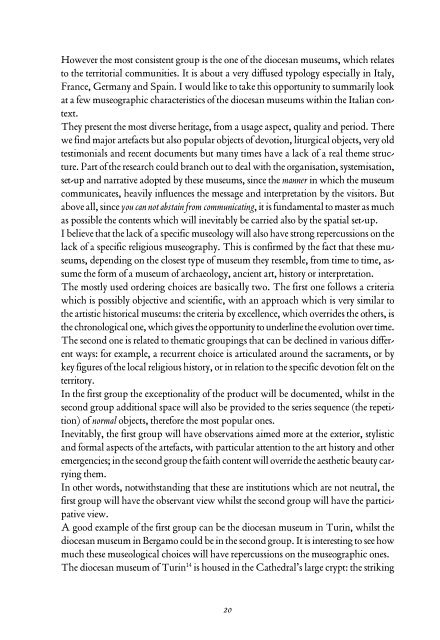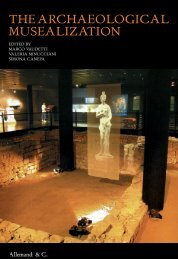RELIGION AND MUSEUMS - Allemandi
RELIGION AND MUSEUMS - Allemandi
RELIGION AND MUSEUMS - Allemandi
Create successful ePaper yourself
Turn your PDF publications into a flip-book with our unique Google optimized e-Paper software.
However the most consistent group is the one of the diocesan museums, which relatesto the territorial communities. It is about a very diffused typology especially in Italy,France, Germany and Spain. I would like to take this opportunity to summarily lookat a few museographic characteristics of the diocesan museums within the Italian context.They present the most diverse heritage, from a usage aspect, quality and period. Therewe find major artefacts but also popular objects of devotion, liturgical objects, very oldtestimonials and recent documents but many times have a lack of a real theme structure.Part of the research could branch out to deal with the organisation, systemisation,set-up and narrative adopted by these museums, since the manner in which the museumcommunicates, heavily influences the message and interpretation by the visitors. Butabove all, since you can not abstain from communicating, it is fundamental to master as muchas possible the contents which will inevitably be carried also by the spatial set-up.I believe that the lack of a specific museology will also have strong repercussions on thelack of a specific religious museography. This is confirmed by the fact that these museums,depending on the closest type of museum they resemble, from time to time, assumethe form of a museum of archaeology, ancient art, history or interpretation.The mostly used ordering choices are basically two. The first one follows a criteriawhich is possibly objective and scientific, with an approach which is very similar tothe artistic historical museums: the criteria by excellence, which overrides the others, isthe chronological one, which gives the opportunity to underline the evolution over time.The second one is related to thematic groupings that can be declined in various differentways: for example, a recurrent choice is articulated around the sacraments, or bykey figures of the local religious history, or in relation to the specific devotion felt on theterritory.In the first group the exceptionality of the product will be documented, whilst in thesecond group additional space will also be provided to the series sequence (the repetition)of normal objects, therefore the most popular ones.Inevitably, the first group will have observations aimed more at the exterior, stylisticand formal aspects of the artefacts, with particular attention to the art history and otheremergencies; in the second group the faith content will override the aesthetic beauty carryingthem.In other words, notwithstanding that these are institutions which are not neutral, thefirst group will have the observant view whilst the second group will have the participativeview.A good example of the first group can be the diocesan museum in Turin, whilst thediocesan museum in Bergamo could be in the second group. It is interesting to see howmuch these museological choices will have repercussions on the museographic ones.The diocesan museum of Turin 14 is housed in the Cathedral’s large crypt: the striking20







